Reproduction of roses by cuttings at home
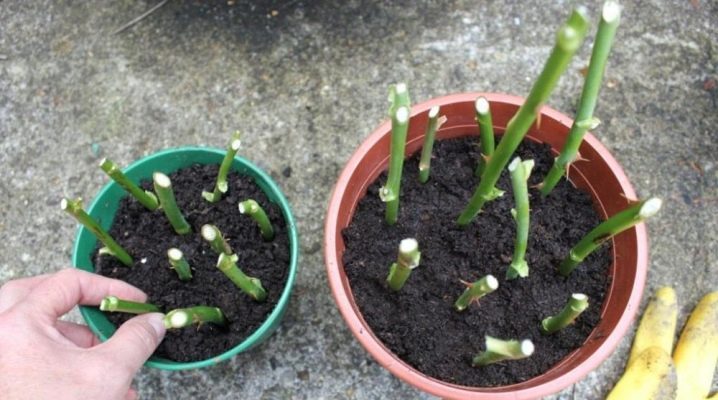
Rose is a very popular plant that attracts many flower growers. It is beautiful, exudes a pleasant aroma, and can be grown without much difficulty. A spectacular flower can be propagated in many ways, such as by cuttings. In this article, we will learn how to do it correctly.

Peculiarities
Many growers who really like roses dream of collecting whole collections of this beautiful flower in their gardens. You can fulfill such a dream with minimal cost by engaging in the correct propagation of culture. The process of self-grafting, carried out at home, is quite laborious and time-consuming. In addition, there are no guarantees of successful results of the operations performed.
It is very important to consider this before starting to breed your favorite flower.
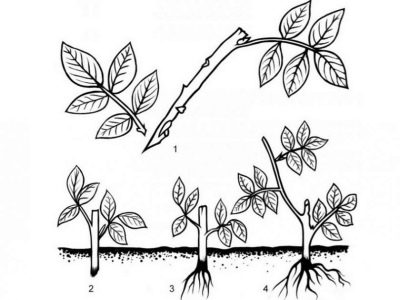
It should be noted that cuttings are one of the most popular methods of rose propagation. This procedure has the following significant advantages.
- Due to correctly carried out cuttings, propagation of the culture guarantees the preservation of all the main varietal characteristics of the mother plant. That is why many growers decide to cut a flower, and not turn to other methods of its cultivation.
- The cost price of this method of cultivating beautiful flowers is as low as possible.
- Thanks to competently carried out cuttings, it becomes possible to obtain an almost unlimited number of seedlings with their own root systems. At the same time, such seedlings will not release wild growth.
- The advantages of the method of cuttings include the adaptability of planting materials to the specific conditions of the territory of their location and growth.
- The considered method of reproduction of a popular culture can serve as a guarantee of long-term flowering. If the grower strictly adheres to absolutely all the rules of cuttings, then the plant will be able to bloom after that for about 10 years, which is a very good indicator.
- The method of propagation by cuttings excludes possible curvature of cuttings in the course of their growth and development. If you do everything correctly and treat all operations responsibly, then later the side stems of the rose will not release.
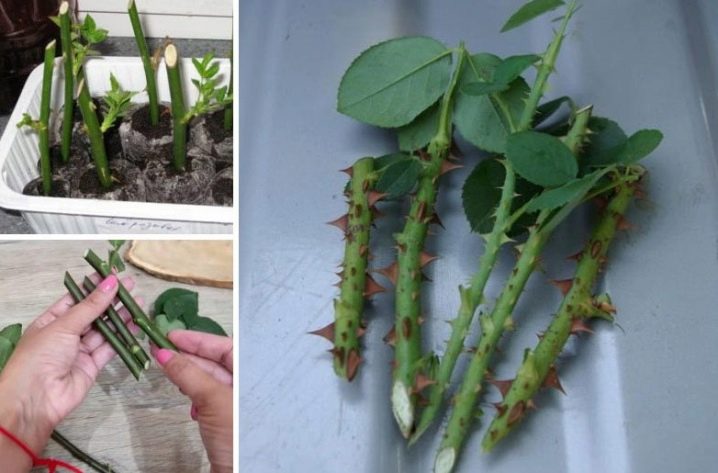
Unfortunately, the considered method of breeding roses demonstrates not only certain advantages, but also disadvantages. A florist needs to know about them before starting grafting of his favorite flowers.
- When roses are propagated by cuttings, predicting the results is impossible, especially when it comes to hybrid plant varieties. As a rule, only those properties and qualities are inherited that are characteristic of the culture from which the rhizome system developed.
- Some rose varieties can be difficult to grow. Worst of all are repaired, yellow and wrinkled plant varieties.
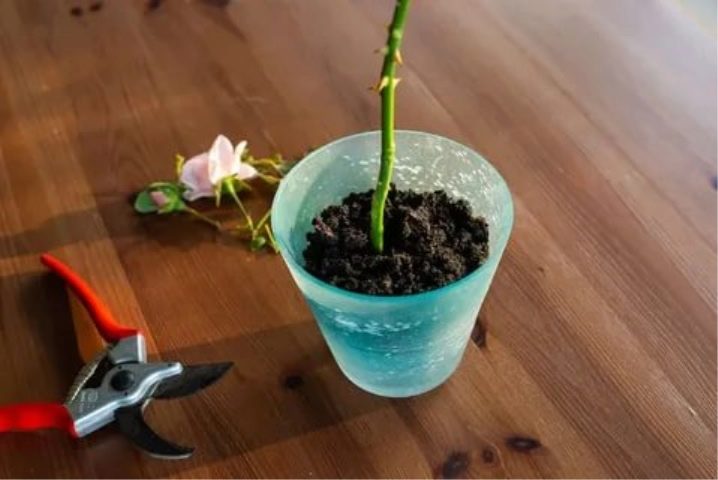
Florists with extensive experience in working with roses and other popular crops are advised to pay attention to the fact that not all varieties of the plants in question demonstrate good rooting. Best of all, the grafting procedure lends itself to polyanthus, climbing small-flowered, miniature, as well as varieties belonging to the Floribunda and Modern Shrub groups.
Not the highest rates of survival are characteristic of yellow, dark red tea-hybrid varieties.
In addition, existing climbing large-flowered and park roses can produce a very low percentage of rhizome formation. Before engaging in the propagation of an attractive plant, all the listed features of its different varieties should be taken into account.
Breeding a rose using the cuttings method is a process that requires the maximum care and accuracy from the gardener. If you act in accordance with all the strict rules, then there is every chance of achieving good results.
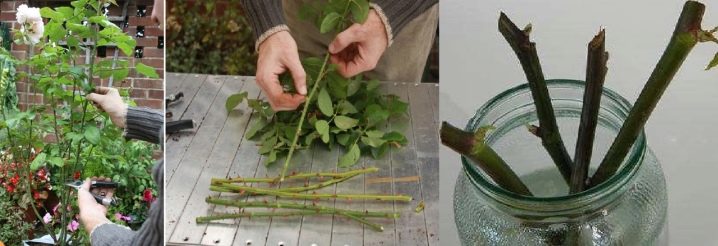
Timing
Reproduction of roses by cuttings should take place within a certain time frame. The latter should ideally fit the plants themselves, be comfortable for their successful and effective rooting.
When choosing the ideal materials for further breeding, experts advise taking into account the seasonal factor. So, greenhouse plants from a bouquet can demonstrate the highest rooting rates in March or April.
Shrub species that grow in open ground conditions root perfectly from mid-June to late July.
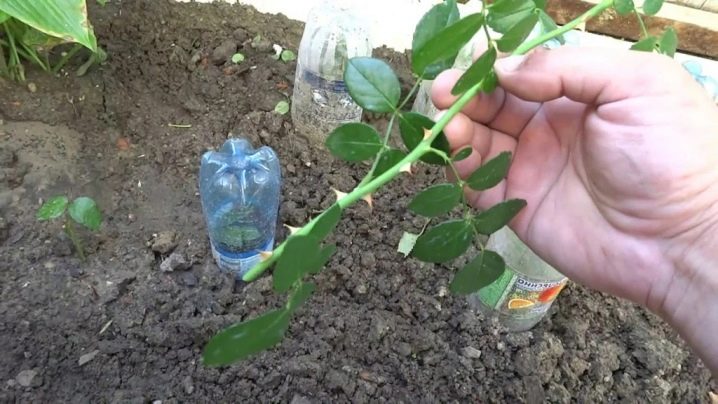
In addition, when choosing a period for harvesting rose cuttings, it is worth starting from a number of basic rules.
- It is very important to consider the time of year. Experienced flower growers recommend cutting shoots at the moment when buds are formed and until the end of flowering, that is, you can start acting in the summer and finish the procedure in the fall. By this time, the plants will have time to accumulate a sufficient amount of nutrients. But in general, you can safely start rooting in early spring.
- It is equally important to pay attention to the degree of maturity of the plant. A suitable stalk should be a small, straight piece of mature, semi-lignified green stem.

Preparation
Regardless of which period was chosen for cuttings, be it autumn, spring or summer, it is very important to carry out the preparatory procedures correctly.
In order for an attractive plant to quickly set up strong and healthy petioles, it is necessary to select and prepare healthy planting material.

When making a choice in favor of certain shoots, it is advisable to build on a number of important features.
- Too young branches or those cuttings that are already lignified do not need to be used.
- Various types of foreign bushes that have just been delivered from the territory of other countries are strongly discouraged to plant and propagate. This is due to the fact that in a new place for them, they may simply not take root.
- For the correct cut, it is required to select only absolutely healthy shoots. The latter should not be lethargic, with any signs of disease.
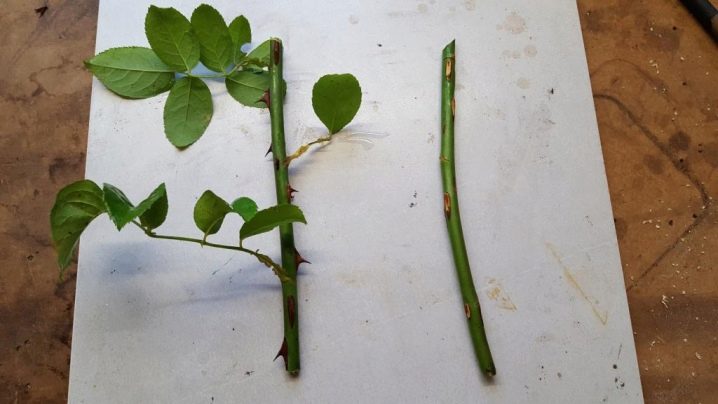
The best solution would be to propagate native plants. These types of roses are more adapted to the procedures in question, since they are well familiar with the climate around them. The appearance of the shoot may indicate the degree of maturity of the flower, as well as its readiness for further reproduction.
For example, if the thorns break off as easily and without unnecessary difficulties, this indicates that the plant is ready for grafting.
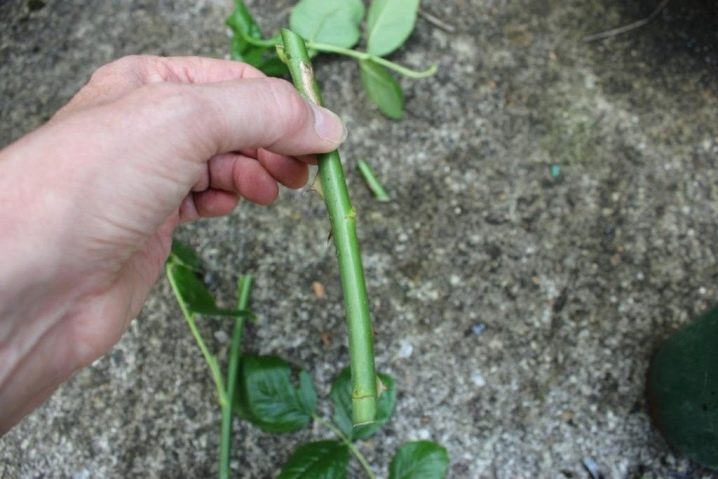
If suitable materials have been selected, you should begin to prepare them. Consider how to properly carry out the preparatory operations.
- Cuttings will need to be taken from fresh stems of roses. The number of formed kidneys must be at least 2. It is also important to pay attention to the length of the cuttings. The optimal parameter is 15-20 cm. The cut diameter should not be more than 1 cm.
- Cutting shoots must be done with a well-sharpened sharp knife. A very sharp secateurs are allowed instead. Beforehand, any instrument must be disinfected. Treatments using regular alcohol are allowed. Disinfection should never be neglected.
- The cut itself must be done in the lower or middle part of the plant stem.The upper cut on the handle should be straight, the lower cut oblique. The bevel angle should be approximately 45 degrees. The smallest permissible distance from the kidneys is 0.5 cm.
- All thorns and leaves must be carefully removed. If there are not very elastic branches, they will also need to be removed.
- A cut flower stalk is sent to a potassium permanganate solution for about 2-3 seconds. The upper cut with a grip of 3 mm must be finished with wax.
- It is advisable to dip the lower half of the cutting into a special solution that has a stimulating effect.
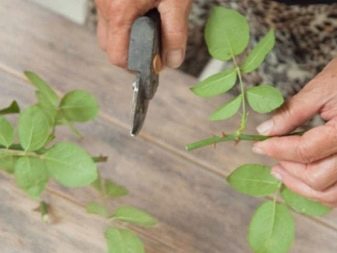
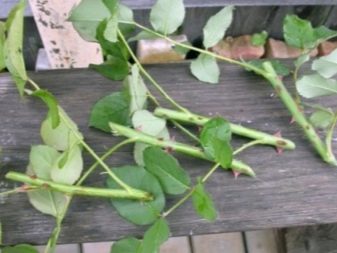
It is quite possible to prepare good and effective stimulants on your own. Here are some popular recipes.
- You can use a combination of 10 g of honey, as well as 0.5 liters of water at a comfortable warm temperature.
- A mixture made up of 50 g of yeast, 0.5 l of heated liquid and 7-8 g of granulated sugar is also suitable.
- It is permissible to drop literally a few drops of aloe juice into the water.
It is necessary to take a very responsible approach to the preparatory procedures, so that in the future the cuttings of the rose demonstrate fast and good rooting.
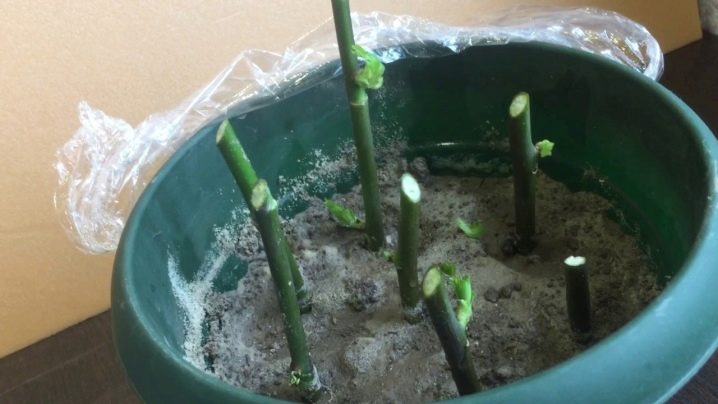
Rooting methods
If successful reproduction of a beautiful color is planned, you need to be aware of the various methods of rooting its cuttings.
The process can take place in water, soil, newspaper, and even potatoes.
Different growers turn to different methods, each of which has its own characteristics, advantages and disadvantages.
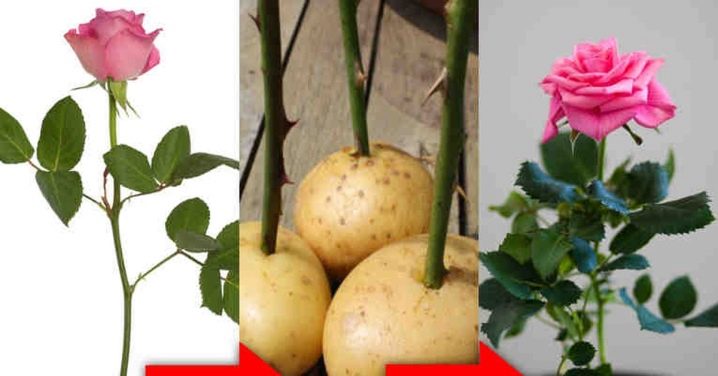
In water
Many growers decide to root rose cuttings in water. Consider how this germination process should be carried out correctly.
- First, the cuttings of the plant are placed in the lower part in a tank filled with water. It should be warm and boiled. The liquid should cover half of the stem. Water can be defended by placing a silver product in it.
- Next, make a suitable top dressing. Suitable drugs such as "Kornevin", or a few drops of aloe juice. For the purpose of disinfection, it is allowed to use charcoal.
- The tank with cut stalks is sent to a lighted place and left so for 14 days.
- You need to create a greenhouse effect. For this, the container is covered with a film material. It is necessary to make small holes in it.
- The water does not need to be replaced. Instead, it is better to top up its volume as it evaporates.
- When the petioles reach a sufficient height (no earlier than a month and a half), they can be safely transplanted into a pot or open ground.
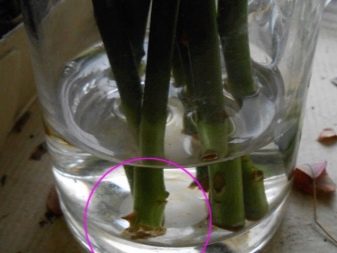
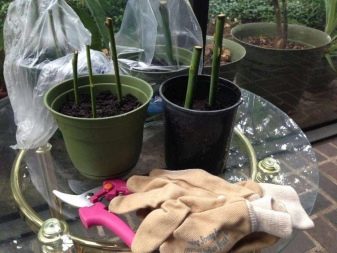
In the soil
You can root the cuttings in the soil. The latter is filled in a pot of suitable size, after which they begin to place the petioles of the rose here.
- First, prepare a suitable pot. It must be absolutely dry and clean.
- Next, you need to properly form the drainage. For this, sand, pebbles or shells are suitable. A special soil mixture for roses is poured on top.
- The prepared stalk will need to be stuck into the soil. At the same time, at least a single kidney should remain on top.
- Then the pot is wrapped with a film material. Several holes are made in it.
- It is important to moisten the soil mixture in a timely manner. Drying must not be allowed. You should wait until the first leaves break through.

In potatoes
It is possible to germinate cuttings of a beautiful rose even in potatoes. Let us find out how this operation proceeds correctly.
- For all procedures, medium-sized root vegetables will be needed. A hole should be made in each vegetable. The diameter of the hole must match the parameters of the handle.
- Next, select the optimal container in the form of a trench with a depth of at least 15 cm. Drainage material is laid on the bottom, and a sand mixture is poured on top. 5-7 cm is enough.
- In the next step, the stalk is placed in the tuber so that it does not fall out of it.
- After that, the roots will need to be planted in the sand, keeping a distance of 15 cm from each other. At least 1 kidney must remain above the soil mixture level. Direct rays of the sun should not fall on the landings.
- From above, each of the potatoes will need to be covered with a glass jar. It has not been removed for at least 3 weeks. After 4-5 weeks, the glass containers can be removed.
- Watering is done using sweet water. For 200 ml of liquid, it is enough to take 10 g of granulated sugar.

Using aloe juice
The root system of a flower can develop very actively if the cuttings are placed in a bag with components soaked in aloe juice. Let's find out how the florist should act correctly.
- First, the selected bag is filled with moss (sphagnum). Before that, it is soaked in water mixed with aloe juice.
- The stalks of the plant are placed in moss, and then moistened.
- Then air is allowed into the bag and tied tightly at the top. The top ends of the seedlings should remain outside the bag.
- Further, such a "container" will need to be carefully hung. You can fix it on the window, but not in direct sunlight. After that, the soil will need to be constantly moistened.
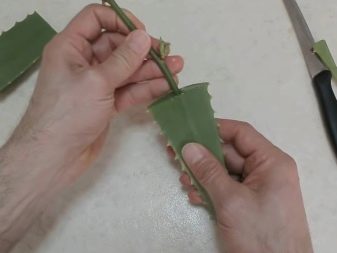

In the newspaper
Rooting cuttings of roses in the newspaper is one of the simplest and most accessible processes. Let's find out what stages it consists of.
- You will first need to prepare moistened newspapers. They will need to be soaked in liquid, but in such a way that the water does not drain from the newspaper.
- Further, in the prepared newspapers, you need to wrap the flower stalks, laying them out like a bundle. Wrapping should be done from all sides. Moisture should not drain from the formed bundle. It is allowed to place it in a damp cloth.
- All components must be placed in a bag. The petioles are stored in this state in a dark place and against a background of temperature indicators of 16-22 degrees Celsius.
- Humidification should be done by spraying and only as needed. At the same time, it is necessary to check the state of the seedling material. If any components start to rot, they should be thrown away as soon as possible.
- Then it remains only to wait for the ejection of the roots (at least 1.5 months). After that, you can start moving into the ground.
The considered method is not very popular, but many growers turn to it regularly.

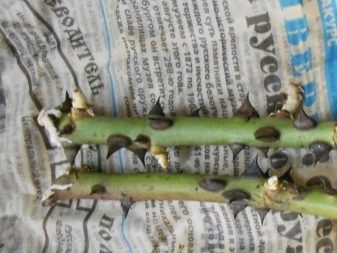
How to plant cuttings?
Let's figure out the main features of planting and growing rose cuttings.
- The garden bed, in the conditions of which it is planned to grow a beautiful culture, must first be well dug up. This is done a month before the direct transplant. Also fertilizing components are introduced into the ground. The ideal ingredients are humus and sand. They are added in 1 part. Mix in 2 times more turf. It is also important to check the condition of the drainage system.
- It is advisable to plant attractive plants in cloudy weather or just before sunset.
- The hole should have a depth of 30 to 50 cm. Of course, a lot depends on the particular type of rose, so the depth may be different. Perhaps, for larger-sized landings, it will be necessary to make holes 2 times larger.
- It is recommended to plant seedlings at temperatures not lower than 21-23 degrees Celsius. The soil must be loose for the seedlings to take root well.
- It is advisable to water the soil with a weak solution based on potassium permanganate so that the plants do not rot.
- Throughout the season, the soil will require fertilization.
- If the temperature readings drop below 18 degrees, the stalk will need to be covered with either a jar or film.
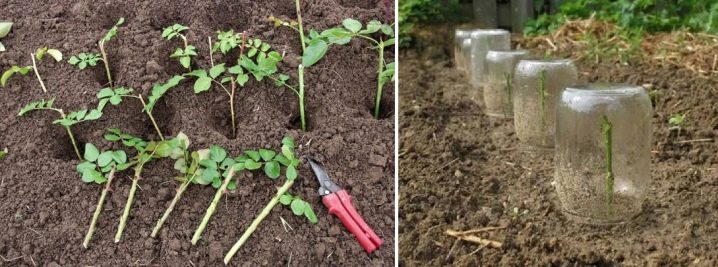
How to care?
After completing all the procedures for transplanting plants to a permanent place of culture, competent care will be required. Consider what procedures will be needed against the background of warm seasons.
- To grow a healthy and beautiful rose, in warm weather, it needs to be regularly watered. However, culture should not be flooded either. In hot summer weather, a couple of waterings per week will be enough.
- The soil is supplemented with sand or sawdust so that the plant has access to oxygen. Fertilizing components are introduced, for example, mineral, but not potash and non-nitrogen compounds.
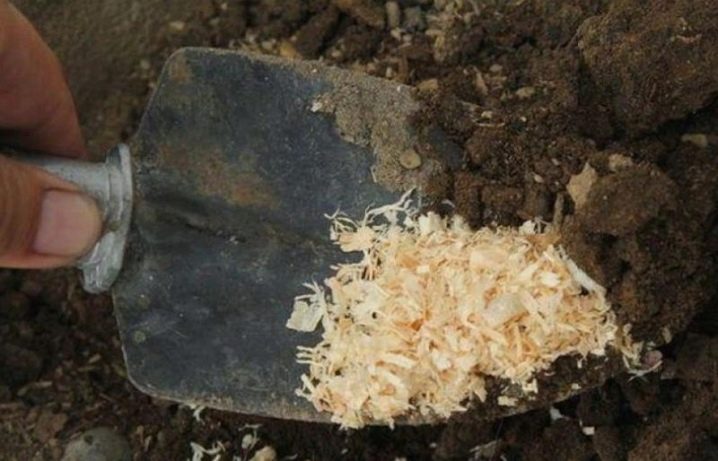
In the cold season, the plant will need such procedures.
- If the flower develops at home, and not in the garden soil on the site, then care must be taken that it does not overheat due to heating started in winter or in autumn. A home rose will feel good at a temperature of +15 degrees. If the temperature is higher, then periodic ventilation is needed.
- In the fall, a rose growing at home is cut off shoots, leaving only 4-5 buds. Watering is done less often - once a week. With the onset of active development of culture, it is fertilized once every 2 weeks.
- If the bush is located on the street, then before the arrival of the first frost, it is pruned, dug up and transferred to a pot. Of course, some varieties are allowed to be left in the ground for the winter, but first they are covered with straw, foliage or sawdust.
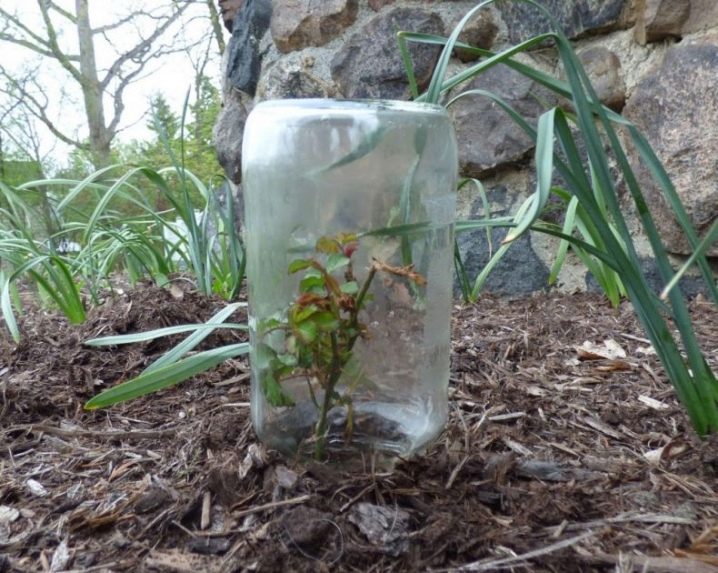

































































































The comment was sent successfully.